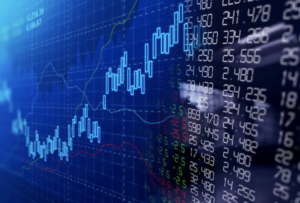
By Sam Parker, Treasurer at King’s Commercial Awareness Society
High-frequency trading, or HFT, is a type of trading that uses advanced technologies and algorithms to execute trades at lightning-fast speeds. Imagine this: while it takes you half a second to click your mouse, HFTs can close a trade in under 10 milliseconds – 50 times faster!
Firms first started using HFT in the late 90s, but it was not until the mid 2000s that it really took off. Today, HFT accounts for a large portion of all equity trades in the US, increasing from less than 10% in 2005 to roughly 65% today. In the UK, the portion of HFT in equity trades is under 30% – much less, but significant nevertheless. It is getting clearer day-by-day that we are in the era of algorithms; this is certainly true in our financial markets, but it remains unclear whether this gives the economy a net positive outcome.
HFT is less dominant in the UK in comparison to the US. This can be attributed to several factors. Firstly, the UK has stricter regulations, making it harder for firms to engage in the activity. Additionally, the financial markets in the UK are not as liquid and are more consolidated than the US ones, making the UK financial markets less desirable for HFT firms to operate in. Furthermore, the technology infrastructure in the UK may not be as advanced as in the US, which can render it harder for HFT firms to execute trades quickly and efficiently. While the US is terraforming the land between New York and Chicago with dynamite and rock saws to accommodate HFT infrastructure to knock off only a few microseconds for trades, the UK seems to be comparatively at a much earlier stage of growth in this industry and has not yet taken measures nearly this extreme.
Advantages and Disadvantages
HFT has its benefits, like speed, efficiency, flexibility, and reduced impact of emotions. But, it also has its drawbacks, like increased market volatility and instability, reduced market liquidity, risk of technical failures and system errors, and risk of market manipulation and insider trading.
HFTs can execute trades faster than human traders, making them a competitive edge for firms. They can also process large amounts of market data in real-time, which can lead to more consistent and profitable results. They can be used for a variety of trading strategies, such as statistical arbitrage, market making, and liquidity provision, which can help traders adapt to changing market conditions. However, they can also exacerbate market fluctuations by quickly buying and selling large quantities of securities in a short period of time, leading to sudden price movements and increased volatility, making it more difficult for investors to make informed decisions. They use their advanced technology and high-speed trading capabilities to gain access to sensitive information and manipulate the market for their own benefit, undermining the integrity of the market. It is the general consensus that the “Flash Crash” of May 6, 2010 was exacerbated by an “algorithmic loop”, a phenomenon where many HFT algorithms were interacting with each other in a market, causing a feedback loop of buying and selling. In this case, the loop caused the most rapid decline that ever occurred throughout history.
Regulating HFT
The British government has taken action to level the playing field for HFT firms. The Financial Conduct Authority (FCA) has implemented regulations to increase transparency in HFT, including requiring firms to disclose their strategies. They have also put a stop to HFT firms exploiting “stale quotes” for profit by proposing new rules to limit their maximum duration.
The FCA has ensured that firms have robust systems in place to detect and prevent market manipulation. They have even cracked down on “spoofing” and “layering” tactics, which involve placing and cancelling orders with the intention of manipulating prices.
In 2020, the FCA proposed new regulations to limit the amount of trading that can be done by HFT firms on certain markets such as imposing a tax of £42,000 for every £1bn traded to protect the stability of the markets and reduce the risk of flash crashes.
In the US, during the late 90s and early 2000s, the SEC made changes that greatly impacted the stock market. They passed regulations such as Reg. NMS to promote competition and transparency between different exchanges, which led to the rise of electronic trading platforms and allowed traders to take advantage of high-frequency trading techniques. These changes helped level the playing field and gave investors more options for buying and selling stocks. Since the “Flash Crash” of 2010, there has been even more regulation such as “Kill Switches” to prevent trades causing another economic emergency. It is very likely that HFT will become more regulated as more unforeseen problems occur.
High-Frequency Trading has grown significantly in recent years. Thanks to the rapid advancements in technology and the use of advanced algorithms, firms have seen benefits such as speed, efficiency, flexibility, and a decrease in the amount of errors made. But HFT leads to some disadvantages for the financial entity using it and the market in general. Market volatility, instability, reduced market liquidity, risk of technical failures as well as system errors, risk of market manipulation and insider trading are just some problems that have been exacerbated by HFT. The future of HFT remains uncertain, but it’s likely that we will continue to see growth in usage alongside more regulations and oversight to ensure that the market remains fair and stable for all participants.
I was very pleased to find this web-site.I wanted to thanks for your time for this wonderful read!! I definitely enjoying every little bit of it and I have you bookmarked to check out new stuff you blog post.